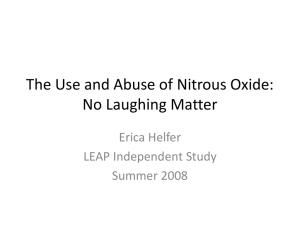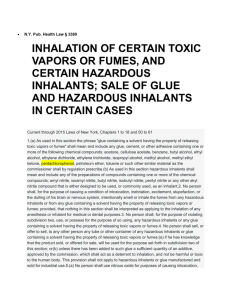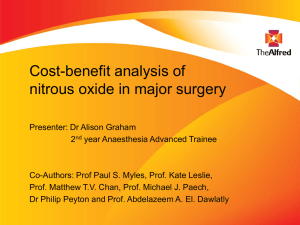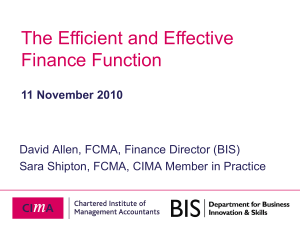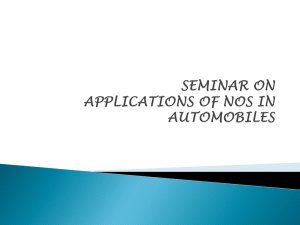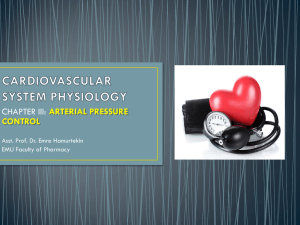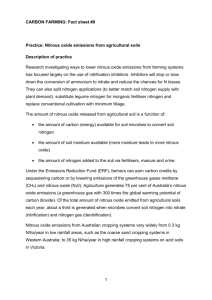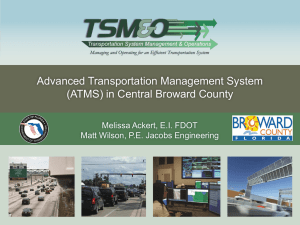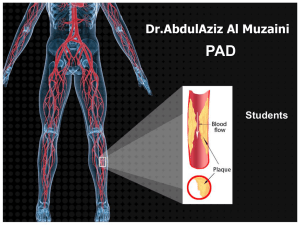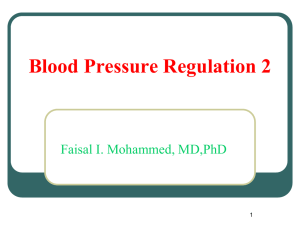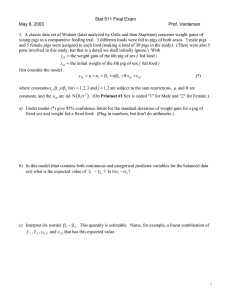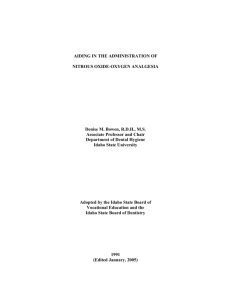Second Gas Effect and * - Oakland University
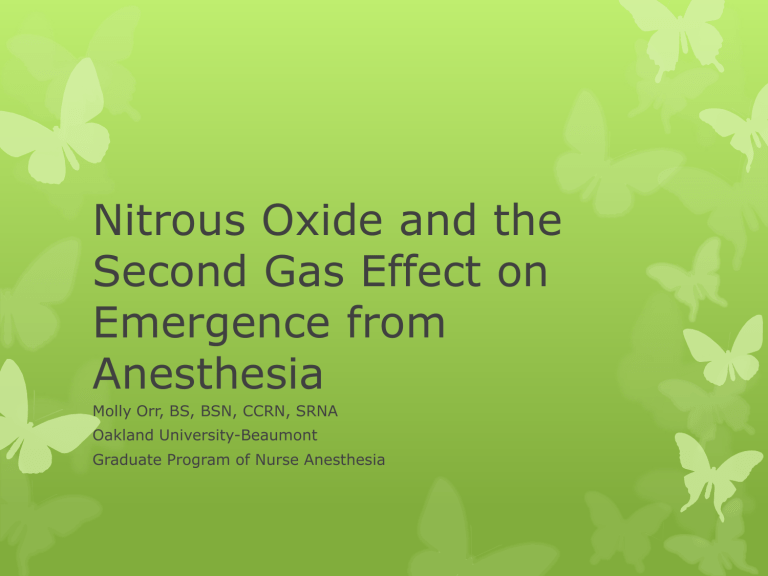
Nitrous Oxide and the
Second Gas Effect on
Emergence from
Anesthesia
Molly Orr, BS, BSN, CCRN, SRNA
Oakland University-Beaumont
Graduate Program of Nurse Anesthesia
Peyton, P. J., Chao, I., Weinberg, L., Robinson, G. J. B., &
Thompson, B. R. (2011). Nitrous oxide and the second gas effect on emergence from anesthesia. Anesthesiology,
114(3), 596-602.
Departments of Anesthesia and Surgery, Austin Hospital,
Melbourne, Australia
Department of Surgery, University of Melbourne,
Melbourne, Australia
Definition
What is second gas effect?
What do we know about it?
Why is it important?
Study concept
Does the elimination of N2O affect the rate of decrease in end-tidal and arterial sevoflurane concentrations
(…and thus speed emergence)?
The null hypothesis: The rapid diffusion of N2O at the end of inhalational anesthesia has no effect on the rate of reduction in end-tidal and arterial concentrations of volatile anesthetic (i.e. sevoflurane)
Study design
Randomized controlled study
Patients randomly assigned to experimental or control group via sealed envelope (N=20)
Control group (n=10): Gas mixture of sevo in air-oxygen
Experimental (nitrous oxide) group (n=10): Gas mixture of sevo in a 2:1 mixture of nitrous oxide-oxygen
Inclusion criteria
Adults (> 18 yo) capable of giving informed consent
General surgery at least 1 hour duration
Requires arterial line for hemodynamic monitoring
Arterial line samples used for gas analysis
Exclusion criteria
History of severe lung disease (PFT criteria)
Symptomatic ischemic heart disease
Super obesity (BMI>45)
Pregnancy
H/O severe PONV
Critically ill/immunologically compromised
Vit B12 or folate deficiency
Presence of gas-filled, space occupying lesion
Methods used
Premed: 1-2 mg midazolam IV
Standard monitoring + arterial line + BIS
Preoxygenated
Induction: 1.5-2.5 mg/kg propofol IV, opioids (1-2 mcg/kg fentanyl and/or morphine 0.05-0.1 mg/kg), nondepolarizing neuromuscular blocker
Endotracheal intubation, controlled ventilation 12-15 breaths/min, EtCO2 maintained 28-33 mmHg
Maintenance: Inhalational anesthetic mixture (with airoxygen or with nitrous-oxygen) initiated and sevo concentration adjusted to maintain BIS 40-60 (N2O does not affect BIS!)
Normothermia with forced air warming device
Methods cont’d
At conclusion of surgery:
Baseline 10 mL arterial blood sample + 1 mL sample for respiratory blood gas analysis
End-tidal gas concentrations over 20 sec recorded simultaneously with gas analyzer
Baseline hemodynamic, ventilation data, SpO2, temp and
BIS numbers recorded
After baseline obtained, neuromuscular blockade reversed with 2.5 mg neostigmine and 0.4 mg glycopyrrolate, fresh gas mixture changed to 100% O2 at 9 L/min
Methods cont’d
Arterial blood gas samples drawn, end-tidal gas analysis, and other vital data collected at 2 min and 5 min
Patient then loudly commanded to open his or her eyes, command repeated every 30 sec until response; time from command until eye opening was noted
Extubation after standard criteria met; time to extubation noted
Final arterial blood gas sample obtained in PACU at 30 min
The dependent variables: Primary and Secondary Endpoints
“Primary study endpoints”:
Differences in the fraction of baseline partial pressures of sevoflurane in arterial blood at 2 min and 5 min
End-tidal sevo partial pressures at 2 min and 5 min
End-tidal and arterial concentrations of CO2 were also determined at 2 min and 5 min
“Secondary study endpoints”:
BIS number comparisons between the two groups at 2, 5, and 10 min
Time to eye opening
Time to extubation
Statistical Analysis
Estimated 20 patients required for analysis
Two-tailed t test for unpaired data (with Bonferroni correction for multiple measurements in each patient)
Two-way ANOVA to determine whether any measured differences changed significantly over time
Best-fit curves for primary endpoints were generated using least squares method
Two-tailed t test used for secondary endpoints (after
Kolmogorov-Smirnov normality testing)
P value of 0.05 or less considered statistically significant
Results/Conclusion
During the first 5 min after conclusion of anesthesia, the arterial partial pressure of sevo was 39% higher in the control group than in the nitrous oxide group (P<0.04), but was not found to be statistically significant at 2 min and 30 min
End-tidal differences in sevo were not significant between the two groups at 2 min and 5 min
PaCO2 decline at 2 min was significant in N2O group vs. the control group (d/t diffusion hypoxia), but no sig diff remained at 5 min
No significant diff in BIS at 2 and 5 min between two groups
Times to eye opening and extubation were significantly shorter in nitrous oxide group (8 min and 10 min, respectively) compared to control group (11 min and 13 min). [P<0.04]
Strengths of study
Independent variables were consistent between the two groups (e.g. age, sex, weight, operative time, baseline vent parameters, baseline VS, baseline temps and BIS numbers)
Anesthetic technique was standardized between two groups (apart from administration of nitrous oxide)
Measurements conducted in identical manner between two groups
Limitations of study
Small sample size (N=20, two outliers later excluded)
Variations in characteristics of people who enrolled in study (e.g. age, end organ function, smoker vs. nonsmoker, V/Q mismatching, etc.)
Confounding variables as identified by authors, such as trend toward lower HR and BP in nitrous oxide group, which correlates to 10-20% lower cardiac output and may affect alveolar anesthetic concentrations
Use of nitrous with volatile anesthetic reduces volatile anesthetic dose; has “MAC sparing” effect
No statistical significance was found in end-tidal sevo
(i.e. alveolar) concentrations between the two groups
Overall takeaway
How can we use this in practice?
A more rapid emergence?
